Nepenthes ‘Pitcher Plant’ Care With Carnivorous Growers: Don’t Neglect These Factors

CARNIVOROUS > NEPENTHES
Reviewed By COLIN SKELLY

Colin is a Horticulturist and Horticultural Consultant with experience in a range of practical and managerial roles across heritage, commercial and public horticulture. He holds the Royal Horticultural Society’s Master of Horticulture award and has a particular interest in horticultural ecology and naturalistic planting for habitat and climate resilience.
Contributions From KEVIN ZHANG

Kevin has been growing carnivorous plants since 2003 and was actually MACPS’ co-founder, creating the society in 2017. He also exhibits his plants at the Philadelphia Flower Show and has won various awards over the years.

Peter is the Owner of Wack's Wicked Plants, a specialist carnivorous plant nursery based in Yorkshire. The nursery has won several gold medals at RHS Flower Shows across the country, including one at the Chelsea Flower Show in 2019.

Kenny has been growing carnivorous plants for the past 17 years and has experience growing and supplying many different species, including the Venus Fly Trap. He is also the author of the book 'Florida's Carnivorous Plants'.

Megan Webb has been growing carnivorous plants for more than 10 years; within that time she has collected a huge number of carnivorous plant genera and species. Megan has a BSc (Hons) in Horticulture from Writtle University College and is the winner of both the Aberconwy Award and the Alan Martin Award.
NEPENTHES GUIDES
Surely the runaway top choice for a plant to take a leading role in a hair-raising horror film is one of the monster-like pitcher plants.
These true blue carnivores of the Plant Kingdom, over and above insects, relish even small birds and rats!1Nguyen, T. (2009, August 20). Giant Plant Eats Rodents. livescience.com. Retrieved April 18, 2023, from https://www.livescience.com/10561-giant-plant-eats-rodents.html
In this guide, we’ve collaborated with some of the top experts on carnivorous plants and the Nepenthes genus, including Peter Walker, the Owner of Wack’s Wicked Plants.
“I love the shapes, colours and variations of carnivorous plants,” Peter Walker shares.
“The general look of them, their diversity, the trapping mechanism, how they function, how they evolved and their hardiness are all reasons why I’m so passionate about growing them.”
Overview
| Botanical Name | Nepenthes |
| Common Name(s) | Pitcher Plant, Monkey Cup |
| Plant Type | Perennial |
| Native Area | Belt of ocean-separated land stretching from Madagascar in the west and eastern Australia in the east, and spanning South-East Asia and the South China Seas Archipelago |
| Hardiness Rating | H1A-H1C |
| Foliage | Evergreen |
| Flowers | Insignificant flowers in small green-pink racemes |
Sunlight
Preferred
Ample Filtered / Diffused / Dappled Sunlight
Exposure
Sheltered
Size
Height
Varies
Spread
Varies
Bloom Time
April to May
Soil
Preferred
Loam
Moisture
Moist but well-drained
pH
Acidic
From the steamy, tropical rainforests of Indonesia to the moist, cool highlands of the Philippines, this plant caused quite a stir in Europe a couple of centuries ago due to its ability to eat small mammals.2Carnivorous plants: the meat-eaters of the plant world. (n.d.). Natural History Museum. Retrieved April 18, 2023, from https://www.nhm.ac.uk/discover/carnivorous-plants-meat-eaters-of-the-plant-world.html
What’s more, one or two of the biggest Nepenthes species, such as the recently-discovered Nepenthes attenboroughii and Nepenthes rajah, catch and consume rodents and even lizards.3Tropical pitcher plants are beautiful but deadly. (2020, season-03). World Wildlife Fund. Retrieved April 18, 2023, from https://www.worldwildlife.org/magazine/issues/fall-2020/articles/tropical-pitcher-plants-are-beautiful-but-deadly
However, the majority of the species trap and digest insects small and large.
Attracted by nectar, the insects fall into the pitcher, drown in the fluid and are digested by enzymes.4Nepenthales: Droseraceae & Nepenthaceae. (n.d.). Berkeley University. Retrieved April 18, 2023, from https://ucmp.berkeley.edu/anthophyta/caryos/nepenthales.html
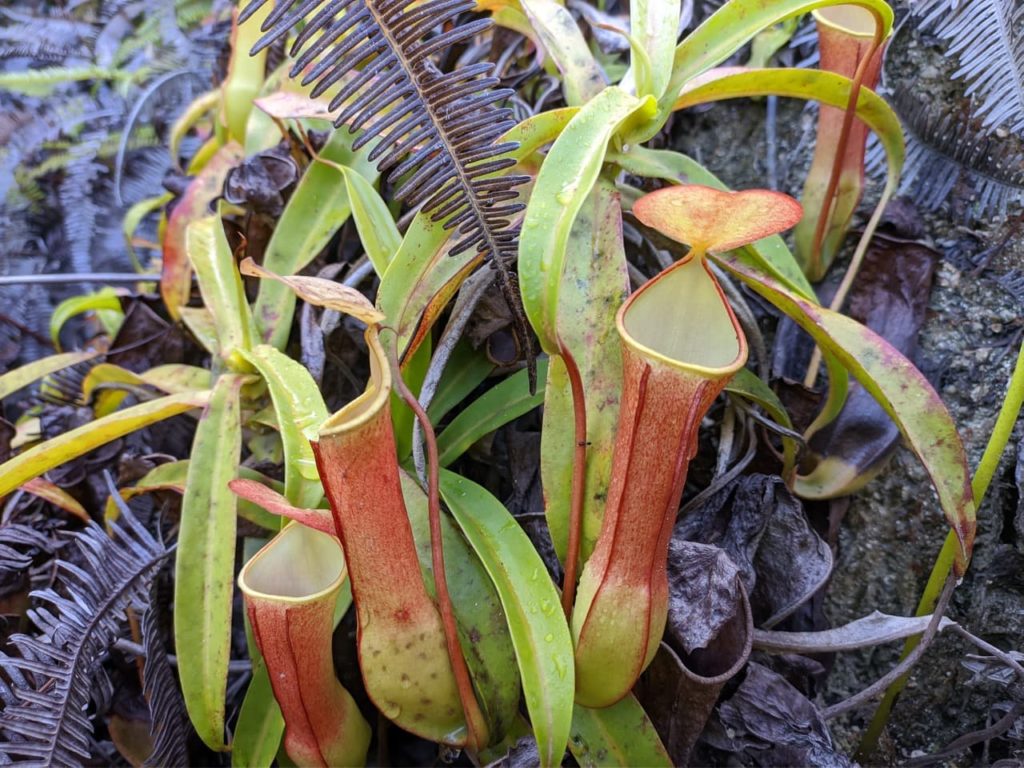
A few of the larger Pitcher Plant species entice shrews or bats to feed or rest on (or inside) the pitcher.
The faeces or guano excreted by these small mammals serves to feed these unusual species.5Nepenthes. (n.d.). Global Biodiversity Information Facility. Retrieved April 18, 2023, from https://www.gbif.org/species/144103386
Different species exhibit pitchers of somewhat different shapes and hues.
Some species’ pitchers do indeed resemble pitchers – while others are more elongated – and some are even short and plump, appearing more jug-like.
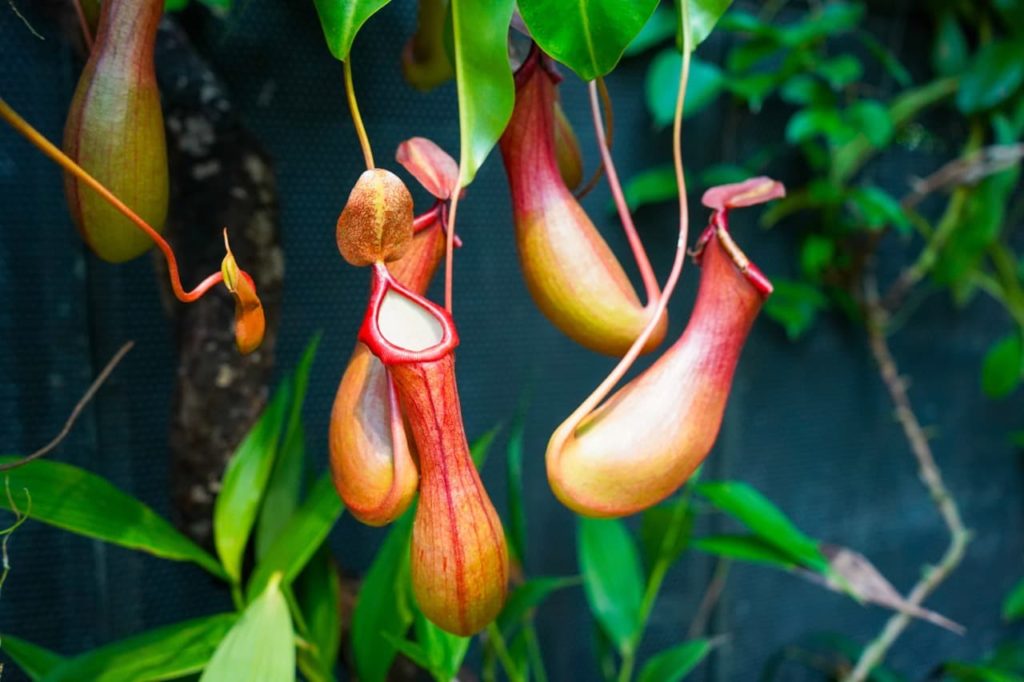
In many species, upper pitchers and lower pitchers on a plant are distinctly shaped.
For the most part, pitchers are a little broader at the base and a little narrower at the neck; the clear majority of species have a lid on the pitcher.
Pitchers are seen in a wonderful assortment of colour tones in greens, oranges, reds and browns.
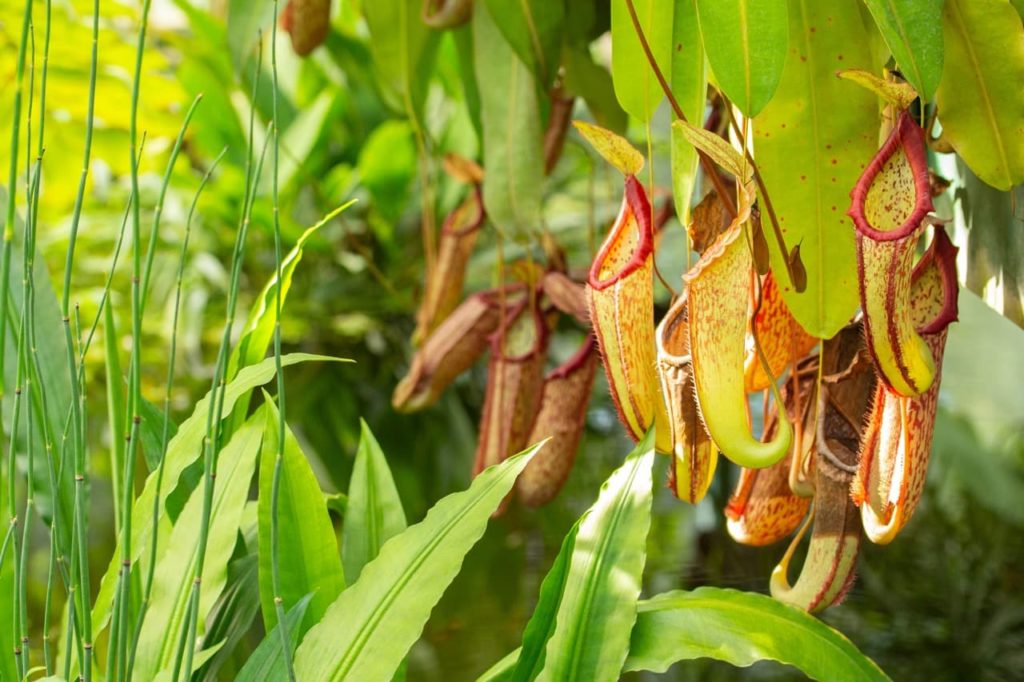
They are often gradated, bi-coloured, striped, speckled or blotched.
The pitchers typically are held up by tendrils that descend from the tips of the leaves.
According to data from Kew Royal Botanic Gardens, 179 Nepenthes species inhabit undisturbed wilderness in a belt of ocean-separated land stretching from Madagascar to Southeast Asia.6Nepenthes. (n.d.-b). Kew Royal Botanic Gardens. Retrieved April 18, 2023, from https://powo.science.kew.org/taxon/urn:lsid:ipni.org:names:327014-2
All are fully tender evergreen perennials.
Common Varieties
“I love all carnivorous plants, but if I had to choose, I would say that I have a particular fondness for the tropical pitcher plants,” says Kevin.
“There are numerous species and the pitcher morphology is extremely diverse.
“Some pitchers are like dainty cups the size of a thimble, while others can hold a gallon of water and are capable of drowning rats.
“Many of the pitchers also have vibrant colours and delicate patterns.
“I especially love Nepenthes ampullaria and its hybrids, which have round, tubby pitchers that can carpet the ground.
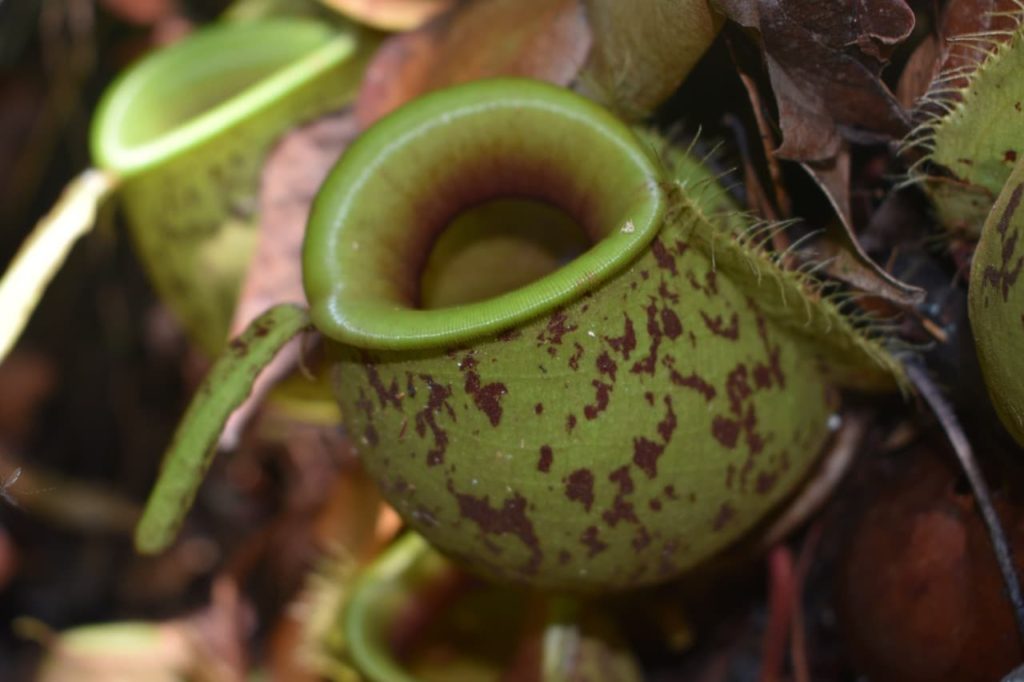
“Although some species of this genus can be hard to grow, requiring temperature drops at night and high humidity, a lot of the hybrids can be grown easily on a windowsill.”
The aforementioned Attenborough’s pitcher plant is, unfortunately, critically endangered, as are nine other species.7Tropical pitcher plants are beautiful but deadly. (n.d.). World Wildlife Fund. Retrieved April 18, 2023, from https://www.worldwildlife.org/magazine/issues/fall-2020/articles/tropical-pitcher-plants-are-beautiful-but-deadly
A limited number of varieties are available, though albeit not in the same way Begonias or Carnations are available at every corner garden centre.
Speciality nurseries stock some varieties of Nepenthes, with Nepenthes alata being the easiest to find.
This plant is often kept as a houseplant and can also be grown in hanging baskets.
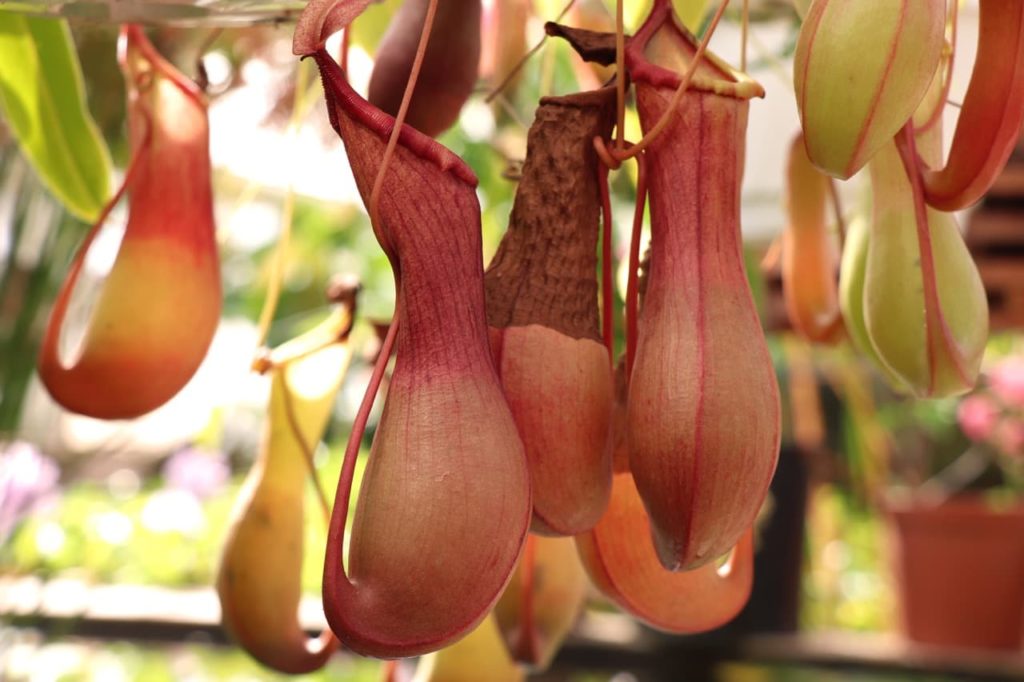
Its pitchers are 18-22cm high and show a range of tones in greens and reds, including intermingled green and red tones and flushes.
Nepenthes hybrider ‘Blood Red’ and Nepenthes sanguinea hybrid are two other varieties that can relatively easily be sourced in the UK.
‘Blood Red’ has pitchers that are light green at the base and reddish in the upper two-thirds, progressively becoming dark red.
Those of Nepenthes sanguinea are rather more of a dusky red hue.
“I enjoy lowland Nepenthes because they are easy for me to grow in my region and they can get massive traps and come in a variety of colours,” shares Kenny.
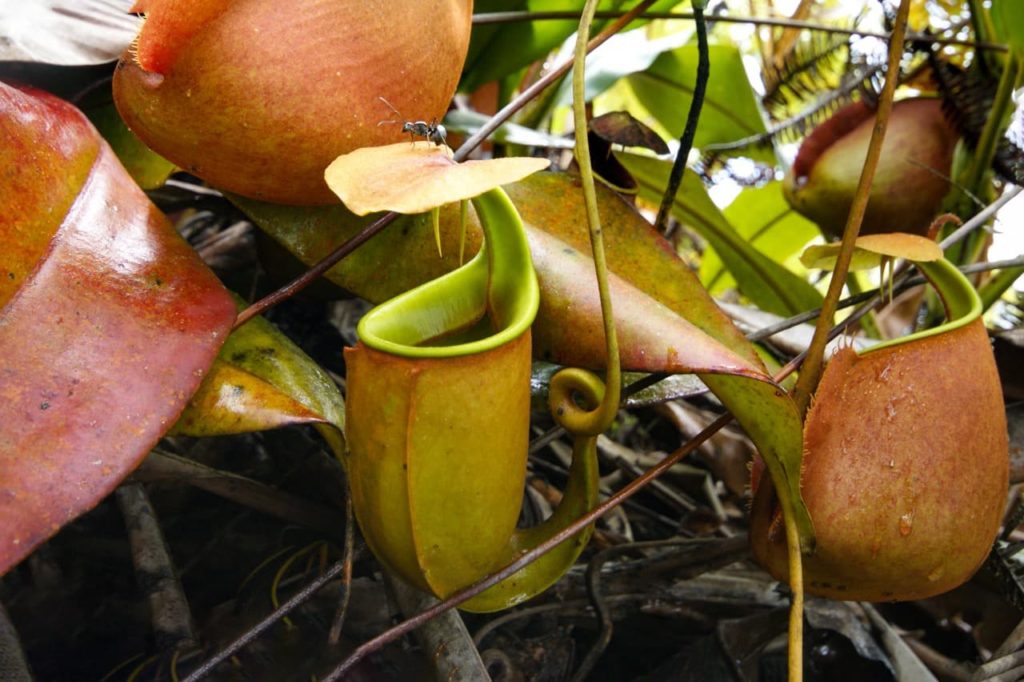
“My favourite species is Nepenthes bicalcarata which has two fangs which drip nectar, which makes it appear that the plant is salivating.”
All three varieties’ pitchers have an elongated shape that is just slightly bulbous at the base.
Not quite as easy to find but still possible to locate in the UK are RHS Award of Garden Merit winners ‘Rebecca Soper’, ‘Bill Bailey’ and Nepenthes × hookeriana.
The first cultivar is especially vigorous and can reach 75cm.
Its pitchers are 12-15cm long and are of a plum to brownish-red hue.

The second cultivar is also a vigorous one with pitchers that are about 10cm and are of a deep red to maroon hue with speckled interiors.
The third one, a hybrid, is comparatively huge at nearly 3m tall and 70cm wide and is also a climbing vine and really needs to be rooted in open ground, for which reason British gardeners can only take a chance on it if they have a conservatory or greenhouse.
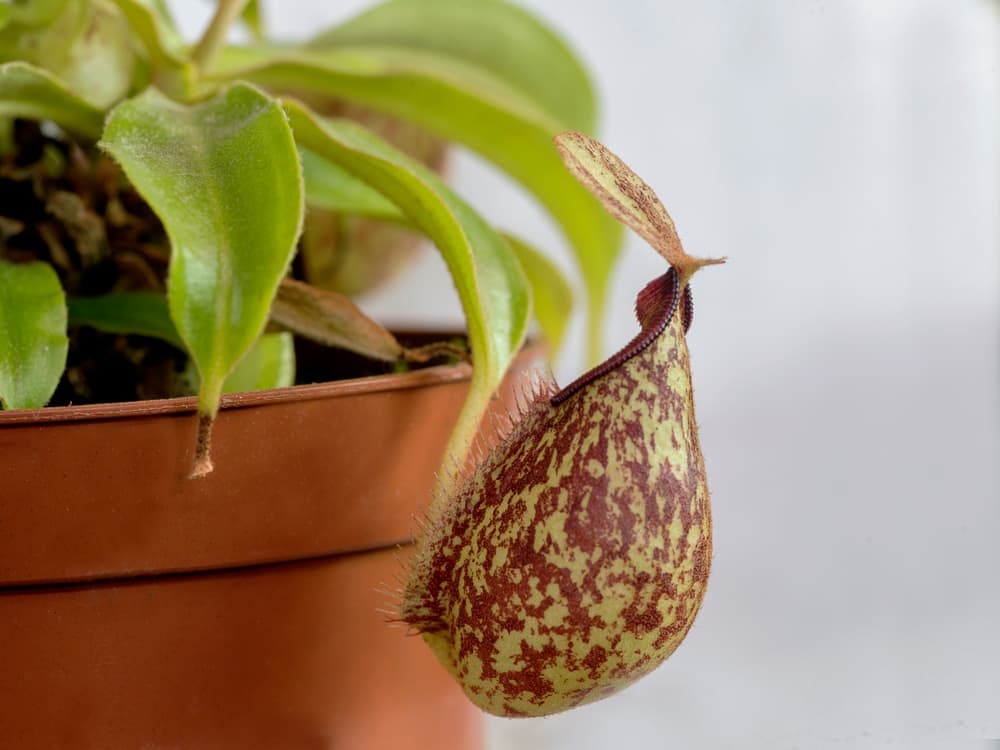
Its pitchers are comparatively little at 10-11cm but they are really eye-catching, sporting deep red speckles and markings on the light green ground in greatly varying balances of red and green.
Though Nepenthes ventricosa is hard to find, it is a relatively not-so-tender and vigorous species that is adaptable to temperate conditions.
How To Grow Nepenthes
Considering the sizeable number of Nepenthes species, the steadily increasing numbers of hybrids and cultivars and their somewhat different native habitats, it is not possible to provide one size fits all growing guidance.
Also, quite a few species, including most of the lowland species, would be quite impossible to grow in British gardens.
As such, our plant care guidelines relate to the varieties named in the previous section.
In general, the highland species and their derivative hybrids and cultivars are possible to grow with some fuss and care in temperate climes, provided they are positioned correctly and the conditions are not very adverse.
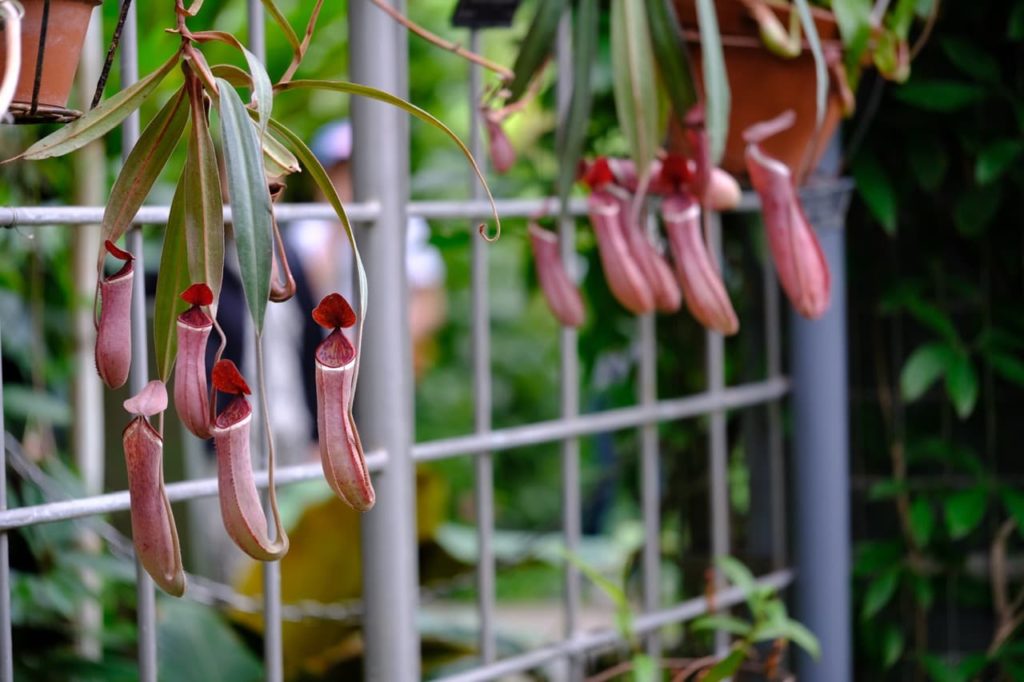
In the UK, Nepenthes may be grown as a houseplant, rooted in nutrient-poor loam.
They may be kept outdoors during warm weather in a sheltered spot in attenuated sunlight.
“If you want to grow Nepenthes outside in the summer months, you can plant up pots that can be moved in and out of glasshouse or conservatory,” shares Master Horticulturist Colin Skelly.
They need to be regularly watered except in winter, when watering should be reduced.
Humidity is very important to Nepenthes’ health and in dry weather, it is wise to mist it regularly.
The aforementioned varieties may be propagated via basal stem cuttings in February, except for Nepenthes × hookeriana, for which April to May is a more suitable timeframe.
Pitcher Plant Care
Our pitcher plant care guidelines are spelt out under factor-specific headings underneath.
Light Exposure
The best type of light for Nepenthes is ample sunlight, usually six hours or more, but it should be filtered, diffused or dappled, such as sunlight coming through a gauze curtain, through textured glass or through the foliage of a tree or a climber.
In my opinion, textured glass is a terrific way to achieve the objective.
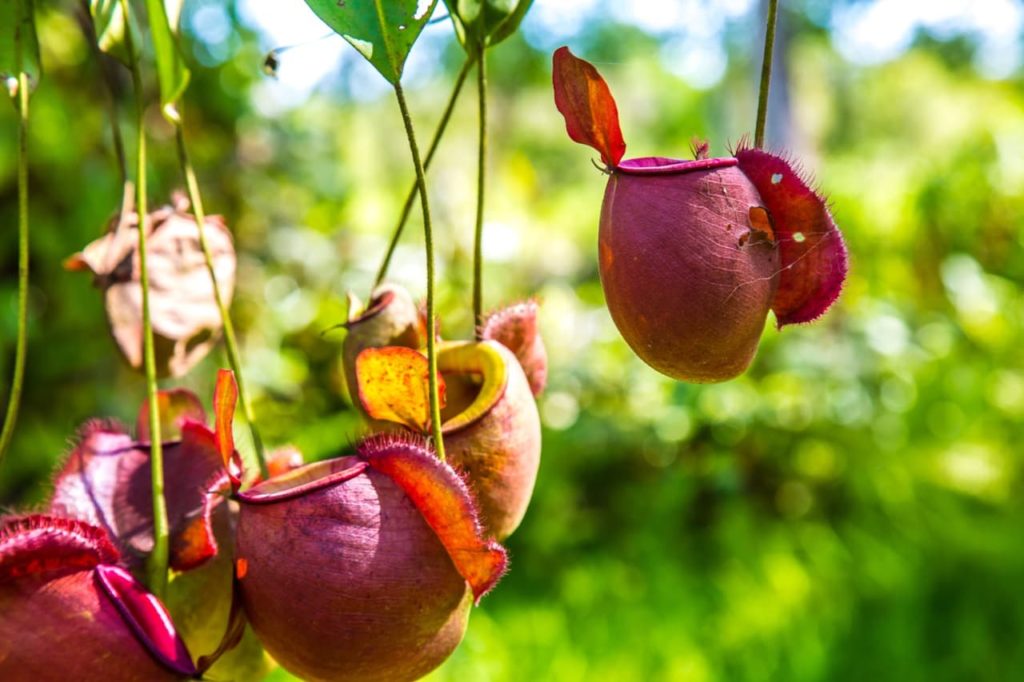
It is easy, affordable and decorative.
It is also adjustable, as textured glass is available in a choice of translucencies and thicknesses.
In the absence of such kinds of indirect sunlight, a few hours of early morning sun followed by some bright shade will serve these plants’ needs quite well.
Humidity & Temperature
The pitcher plant varieties identified above will thrive in temperatures between 21-28°C during the day and 14-18°C during the night.
Though the temperature may cross the upper limits it should really not fall below the lower limits.
Nepenthes × hookeriana requires even warmer temperatures.
All pitcher plants require more humid conditions than most other plants, so the dry atmosphere of most homes (or even conservatories) may be problematic.
It would be best to run a humidifier for several hours every other day near where you keep your pitcher plants.
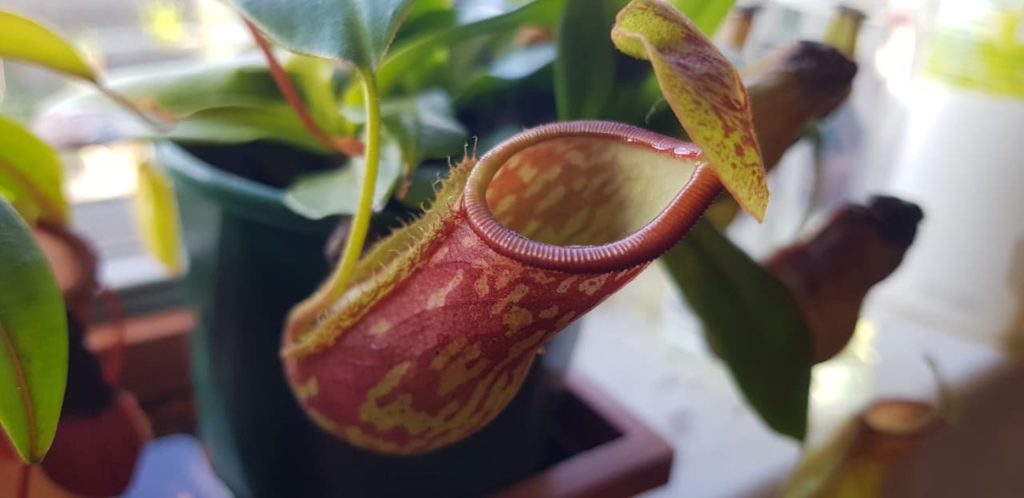
A second option is religiously to mist these plants every day or two – it should be a very fine mist and should be done during mid-morning.
Another very important factor is ventilation and air movement.
A pitcher plant should not be put in a spot where the air is stale and where the air movement is impaired.
It should be in a well-ventilated spot that has good airflow, such as near an open window.
I find you can improve ventilation by running a small table fan at a slow speed for a few hours a day, placed 2-2.5m from the plants.
Watering
The first rule of watering relates to the kind of water.
You should not use tap water for these plants, as the salts present in tap water are toxic to these exotics.
For the same reason, bottled mineral water is also to be avoided.
“The most common problems with these plants is that people use rainwater or forget to water frequently,” shares Peter.
“They are bog plants and need to be kept wet constantly.”
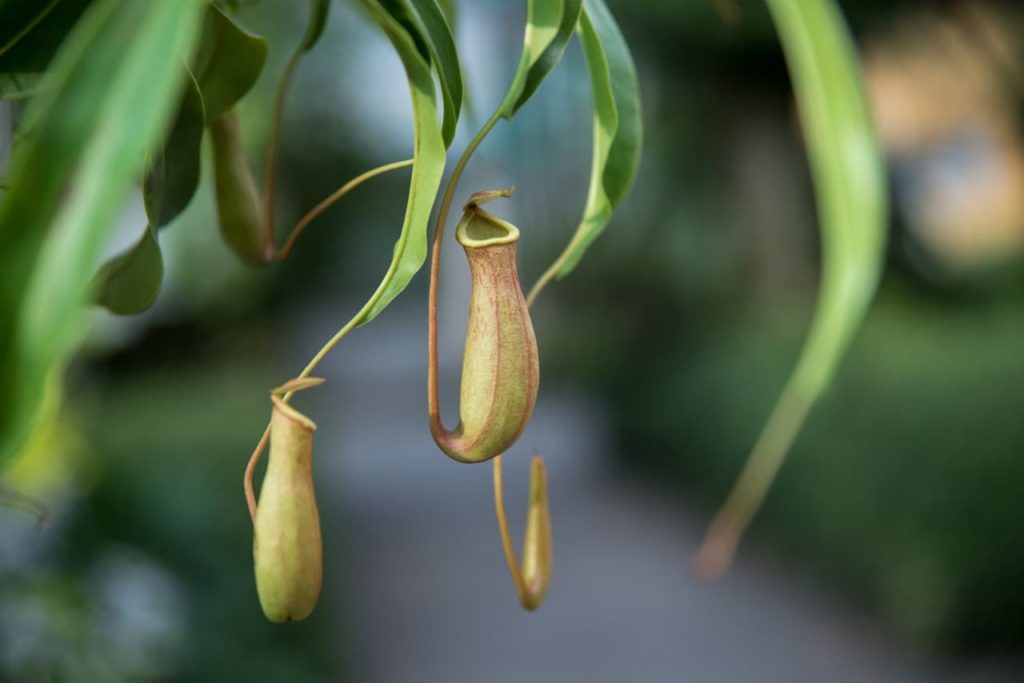
With Peter’s advice in mind, water in moderation but frequently.
The soil must be kept continuously moist, but should never be waterlogged and certainly not dry.
During winter, watering needs are somewhat reduced, but even then the soil should not be allowed to dry out.
Water using a watering can that is fitted with a rose.
If the plant is located indoors, keep an eye on the pitchers as they may well dry out.
If any pitcher is even nearly empty, use a dropper to replenish it with water to about a third of its height.
Soil Requirements
Nepenthes require acidic, low-nutrient soil with very good drainage.
They should not be grown in normal garden soil or any type of commercial compost.
If you can find Nepenthes soil mix made by a reputable manufacturer, I’d suggest you use that.
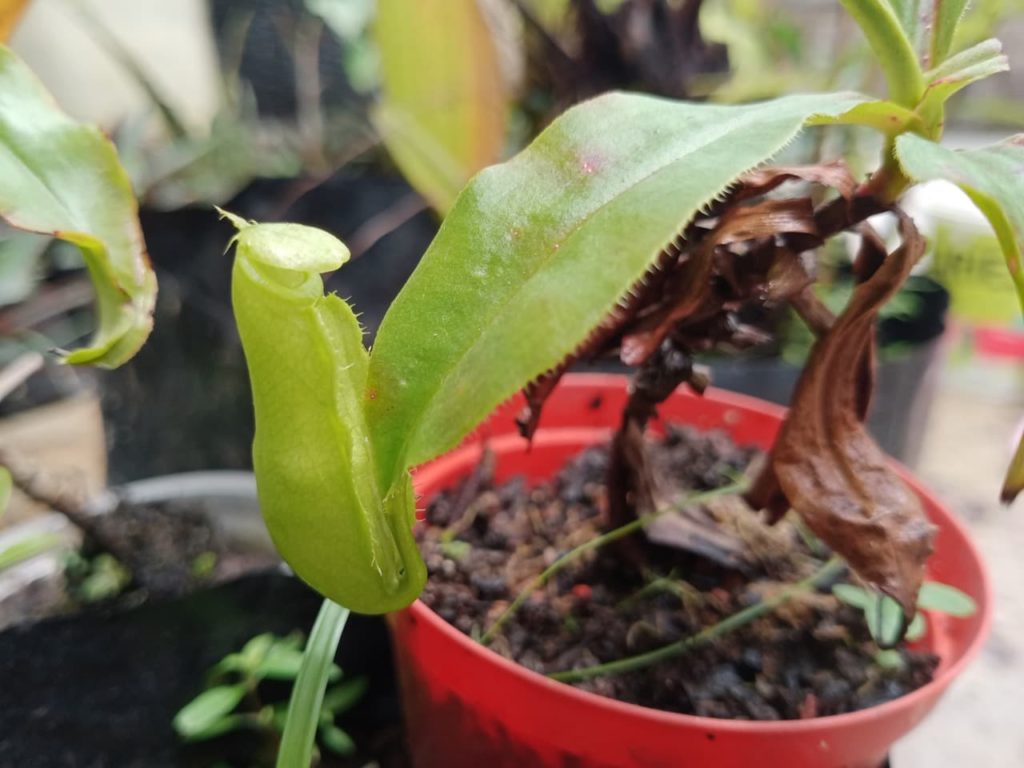
Otherwise make your own using equal parts of the three components listed below, with a choice of components in the first two sets:
- Peat moss, pine bark or fir bark.
- Coco coir or sphagnum moss.
- Perlite.
Do not substitute a component in one set for that in another set.
Another option is to get orchid potting mix.
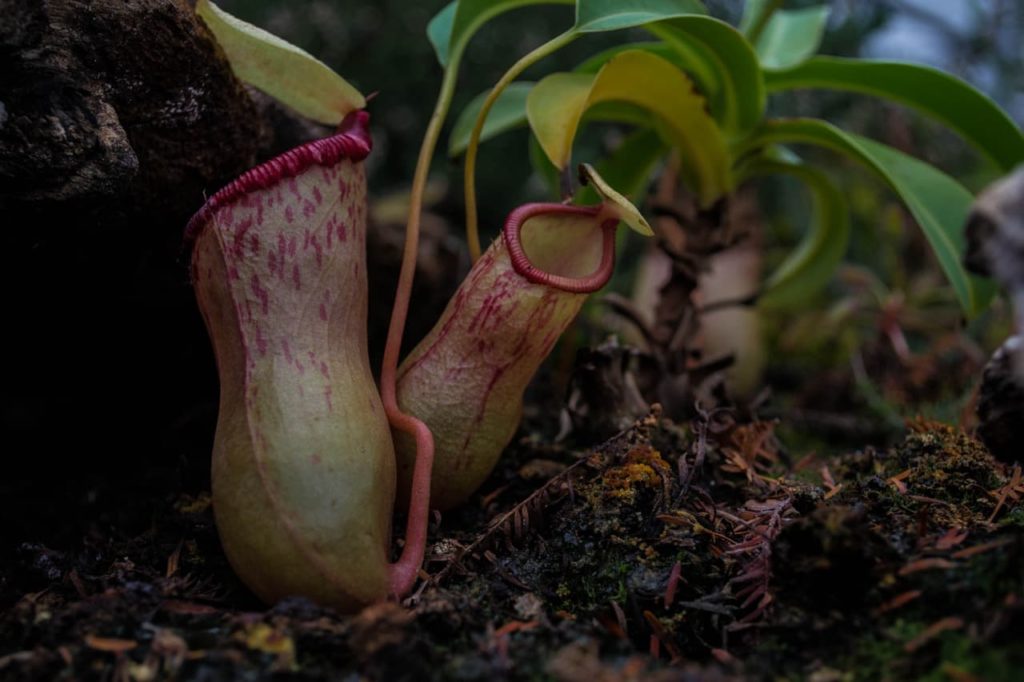
As for pots, the best type of material for these plants, what with their very particular requirements, is natural stone.
Plastic pots will not breathe and may lock in dampness, considering how frequently these plants need to be watered, while clay pots may leach salts and ions which, over time, could lead to buildup that may be toxic for pitcher plants.
Feeding
You may need to feed Nepenthes, except not in the manner you would feed other plants, as they should not be fertilised at all.
Out on the porch or even in the home, provided it is not hermetically sealed, pitcher plants will feed themselves by trapping the odd fly or other insects.
It is definitely preferable for these plants to be located in a place which offers a fair number of insects, whether they’re flying, crawling or both.
In a conservatory, these plants may be unwittingly put on a diet.
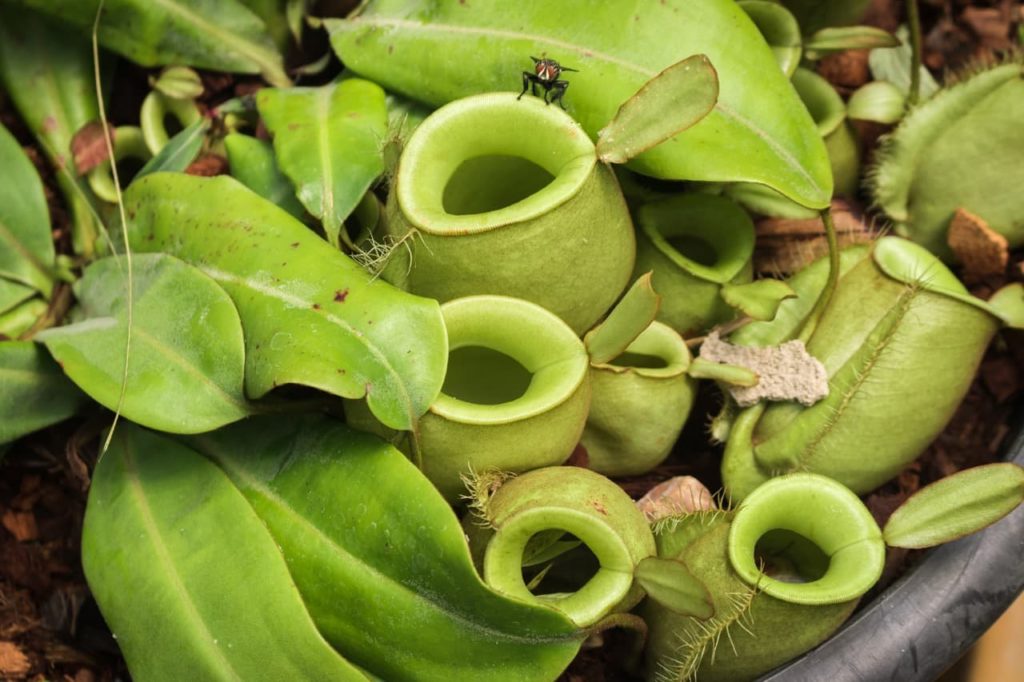
In such a case, drop a freshly-dead housefly or similar-sized insect, be it from the home or the garden, into a pitcher.
The insect should not have been killed with any pesticide.
Feed pitcher plants in this manner by dropping in two small insects in two pitchers every two days or so, but only if insects are not present in the plants’ location and surroundings.
Houseflies and crickets are good choices.
Do not put anything, food or otherwise, other than an insect into a pitcher.
Repotting
Nepenthes plants will not need to be potted on due to nutrient consumption or deficiency, as they do not consume soil nutrients and prefer nutrient-poor soil to begin with.
A plant will need potting up only if it outgrows the pot it is in.
Pitcher plant growth is highly variable as it is strongly dependent on environmental conditions.
If you observe the roots emerging from the bottom of the pot or the plant is clearly too big for its container, promptly pot up to the next-higher-sized container.
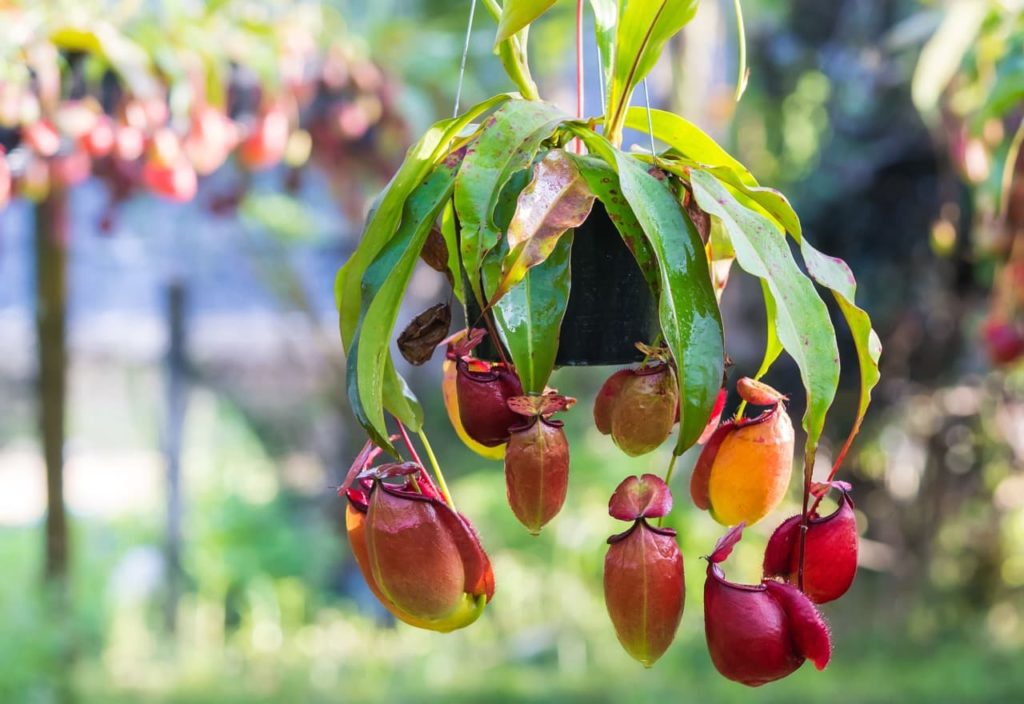
Another reason to re-pot a pitcher plant may be soil degradation or decomposition.
Pitcher plant roots are very delicate, so potting on is a dodgy operation.
Water the plant and remove it with the caked soil and promptly plant it in the prepared pot.
Scatter the soil around and over the roots and merely dab it down without exerting any pressure on it and tap the pot on the ground to settle the medium.
Water in the plant.
Pruning
Pitcher plants do not require pruning as such.
However, you might notice that over time a pitcher starts going brown and begins to wither.
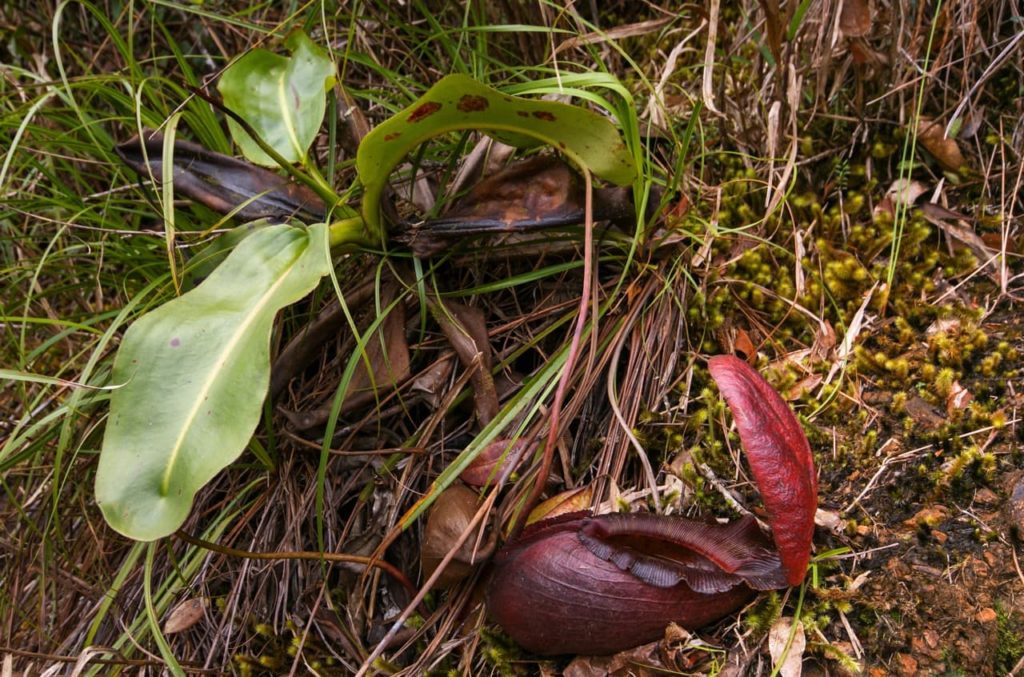
This occurs after a pitcher has trapped and consumed a few or several insects.
Snip off such a pitcher at its tendril’s attachment to the leaf.
Overwintering
Pitcher plants are evergreens and do not enter dormancy in winter.
They should not be confused with Sarracenia or the American Pitcher Plant which does enter winter dormancy.
You need to do nothing different during winter, just ensure that all the care guidelines laid out above are met.
Of course, pitcher plants may not be kept outside even during cool spring or autumn weather, let alone in winter.
Common Problems
In the UK, all you really need to watch out for are aphids and mealybugs.
They can catch fungal diseases, but not if the aforementioned care guidelines are scrupulously followed, particularly the issue of ventilation and air movement.
Aphids and mealybugs are not difficult to tackle but make sure not to use chemical controls on Nepenthes.
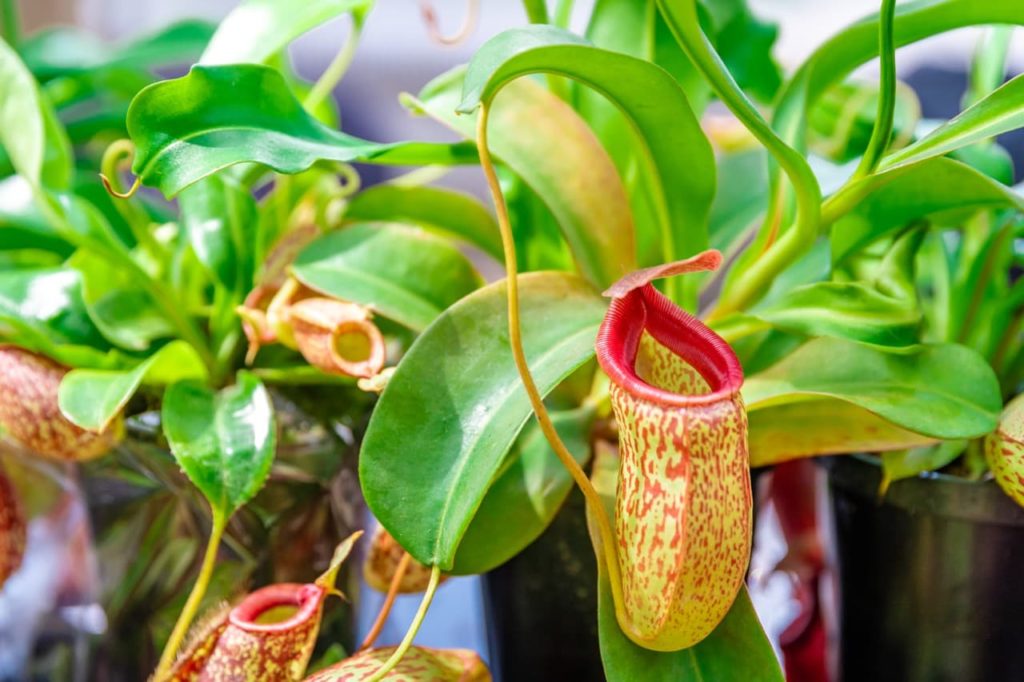
Use biological controls like natural predators, but be aware that these might fall prey to the plants themselves!
An infestation of aphids spotted early can be treated with a blower or canned air, though keep it at a good distance from these delicate plants.
References
- 1Nguyen, T. (2009, August 20). Giant Plant Eats Rodents. livescience.com. Retrieved April 18, 2023, from https://www.livescience.com/10561-giant-plant-eats-rodents.html
- 2Carnivorous plants: the meat-eaters of the plant world. (n.d.). Natural History Museum. Retrieved April 18, 2023, from https://www.nhm.ac.uk/discover/carnivorous-plants-meat-eaters-of-the-plant-world.html
- 3Tropical pitcher plants are beautiful but deadly. (2020, season-03). World Wildlife Fund. Retrieved April 18, 2023, from https://www.worldwildlife.org/magazine/issues/fall-2020/articles/tropical-pitcher-plants-are-beautiful-but-deadly
- 4Nepenthales: Droseraceae & Nepenthaceae. (n.d.). Berkeley University. Retrieved April 18, 2023, from https://ucmp.berkeley.edu/anthophyta/caryos/nepenthales.html
- 5Nepenthes. (n.d.). Global Biodiversity Information Facility. Retrieved April 18, 2023, from https://www.gbif.org/species/144103386
- 6Nepenthes. (n.d.-b). Kew Royal Botanic Gardens. Retrieved April 18, 2023, from https://powo.science.kew.org/taxon/urn:lsid:ipni.org:names:327014-2
- 7Tropical pitcher plants are beautiful but deadly. (n.d.). World Wildlife Fund. Retrieved April 18, 2023, from https://www.worldwildlife.org/magazine/issues/fall-2020/articles/tropical-pitcher-plants-are-beautiful-but-deadly

